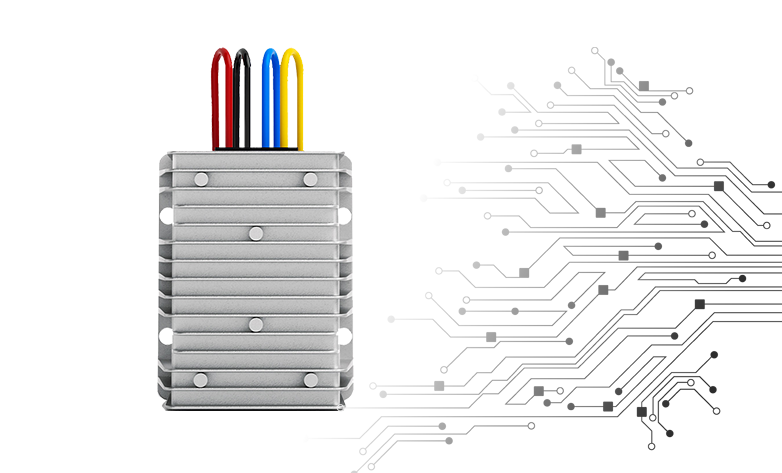Why Portable Power Stations & EVs Use Buck-Boost DC-DC Converters?
In modern electronic devices and renewable energy systems, the buck-boost DC-DC converter plays a critical role. Whether in portable power stations or electric vehicles (EVs), their stable operation depends on this technology. So, why are these devices so reliant on it? This article will explain the key functions of buck-boost converters in three aspects: voltage adaptability, energy efficiency, and system stability.

1. Buck-Boost Converters Can Handle Wide Input Voltage Ranges
1.1 Battery Voltage Fluctuates, but Devices Need Stable Power
Whether lithium-ion, lead-acid, or solar batteries, their output voltage varies with charge levels. For example:
- EV Batteries: A fully charged 48V system may reach 58V, but under low charge, it can drop below 40V.
- Portable Power Stations: Lithium battery packs typically operate between 12V–50V.
Directly using battery power without regulation could cause unstable operation or even damage devices. The buck-boost converter automatically adjusts the output voltage, ensuring a stable 12V, 24V, or 48V regardless of input fluctuations.
1.2 Solar/Wind Energy Systems Depend on It
In solar charging systems, photovoltaic panel voltage changes with sunlight (e.g., 18V in sunlight, dropping to 10V on cloudy days). Without regulation, charging efficiency plummets. The buck-boost converter dynamically adjusts voltage to maintain maximum power point tracking (MPPT), optimizing energy harvest.
Conclusion: The buck-boost converter acts as an "intelligent voltage regulator"—without it, renewable energy and battery-powered systems would struggle to function reliably.
2. Buck-Boost Converters Improve Energy Efficiency
2.1 Buck-Boost Converters Improve Energy Efficiency
Older solutions like linear regulators (LDOs) only step down voltage, often with <60% efficiency, wasting excess energy as heat. For example:
- Input 12V, output 5V: Efficiency drops to ~40%, with 60% lost as heat!
- In EVs or high-power portable stations, such inefficiency causes overheating and potential failure.
2.2 Buck-Boost Converters Achieve >90% Efficiency
Using high-frequency switching (PWM control), buck-boost converters minimize losses, typically reaching 85–95% efficiency. Examples:
- During EV acceleration, battery voltage may sag, but the motor still needs high voltage—the converter boosts dynamically to maintain performance.
- Portable stations power diverse devices (e.g., 12V coolers, 19V laptops) by adjusting voltage on demand, reducing waste.
Conclusion: High efficiency extends EV range and portable station runtime, making buck-boost tech essential for energy savings.
3. Buck-Boost Converters Ensure Safety and Stability
3.1 Prevent Battery Over-Discharge, Extending Lifespan
If lithium batteries discharge below 3.0V per cell, they suffer permanent damage. Buck-boost converters: Automatically boost voltage when battery levels drop, preventing sudden shutdowns. Step down voltage if overcharged (e.g., from solar panels), protecting the battery.
3.2 Enable Bidirectional Energy Flow (Regenerative Braking in EVs)
Advanced EVs and power stations use bidirectional buck-boost converters to both supply and recover energy. Examples: During EV braking, the motor acts as a generator, feeding energy back to the battery—the converter adjusts voltage for optimal storage.
3.3 Strong Noise Immunity for Harsh Environments
Portable stations and EVs face temperature swings, vibrations, and electromagnetic interference. Buck-boost converters utilize closed-loop control to dynamically stabilize their output, outperforming traditional regulators.Conclusion: More than just "voltage adjusters," buck-boost converters are "system guardians," ensuring reliability under tough conditions.
Summary: Why Are Buck-Boost Converters Indispensable for Portable Power and EVs?
- Wide Voltage Adaptation: Handles battery/renewable energy fluctuations for stable output.
- High Efficiency: Saves 30%+ energy compared to older solutions.
- Safety & Stability: Prevents overcharge/discharge, enables energy recovery, and resists environmental stress.
In EVs, portable power, and solar systems, the buck-boost DC-DC converter is now a core component. Future advancements like GaN (gallium nitride) and SiC (silicon carbide) will make them smaller and even more efficient, further revolutionizing clean energy tech. Without buck-boost converters, modern electric mobility and off-grid power would grind to a halt!


